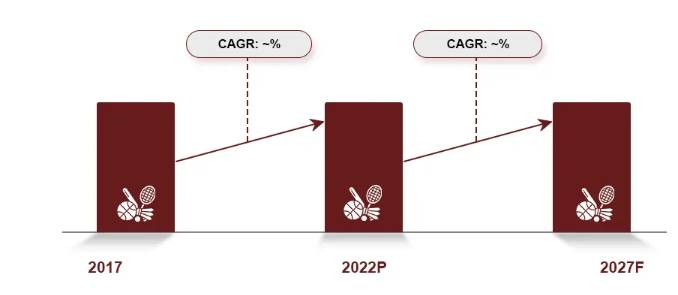In the vibrant tapestry of India’s economic landscape, the sports manufacturing industry stands out as a dynamic and rapidly evolving sector. The industry has flourished, driven by a gifted Labor force consequently known for its role in creating employment and adding to the nation’s economy. 60 % of Indian sporting goods are exported and around 500,000 people are employed in the sports goods manufacturing sector in India. The synthesis of innovation, skill, and a passion for sports has propelled India into a prominent position in the global sports manufacturing market. In this blog, we will explore the Indian sports manufacturing industry, offering a detailed analysis, an overview of its current state, and a glimpse into the future outlook that promises sustained growth and economic prosperity.
Indian Sports Manufacturing Market Industry Overview

The Indian sports manufacturing industry is a diverse and multifaceted sector that encompasses the production of a wide range of sports equipment, apparel, and accessories. From cricket bats to athletic shoes, India has emerged as a significant player in the global sports manufacturing market. The industry’s foundations are built on a rich history of sports culture in the country and a commitment to excellence in craftsmanship.
Sports Manufacturing Industry Analysis
Analyzing the sports manufacturing industry in India reveals a robust and resilient sector that has successfully navigated challenges while capitalizing on emerging opportunities. Several factors contribute to the industry’s strength:
1. Traditional Strengths: India’s expertise in manufacturing has historical roots, and this craftsmanship extends to sports equipment. Traditional sports like cricket and hockey have driven the demand for high-quality manufacturing processes.
2. Diversification of Product Range: The industry has diversified its product range to include a variety of sports and activities. From cricket and football to fitness and adventure sports, manufacturers in India cater to a broad spectrum of sporting needs.
3. Global Recognition: Indian sports equipment has gained international acclaim for its quality and durability. This recognition has resulted in increased exports and collaborations with global sports brands.
Sports Manufacturing Industry Size and Share

The sports manufacturing industry in India is witnessing steady growth, and its size continues to expand. As of the latest data, the market is valued at over $2 billion, and it is expected to continue its upward trajectory. The industry’s share is distributed across various segments, including cricket equipment, athletic wear, fitness accessories, and more.
One of the significant contributors to the industry’s growth is the increasing awareness of fitness and a surge in sports participation across different age groups. This has led to a surge in demand for sports equipment and apparel, further fueling the market’s expansion.
Sports Manufacturing Industry Growth
The Indian sports goods market is estimated to grow to $ 6.6 billion by 2027 from $ 3.9 bn. in 2020–21. The growth of the sports manufacturing industry in India is influenced by several key factors:
1. Rising Sports Culture: The burgeoning sports culture in India, coupled with government initiatives promoting fitness and sports, has created a favorable environment for the industry to thrive.
2. Infrastructure Development: The development of sports infrastructure, including stadiums, training facilities, and fitness centers, has created a demand for high-quality sports equipment, driving industry growth.
3. E-commerce Boom: The rise of e-commerce platforms has significantly expanded the reach of sports manufacturers. Online retail has made sports equipment and apparel more accessible to consumers across the country.
4. Innovation and Technology: Continuous innovation in materials, design, and technology has allowed Indian sports manufacturers to produce cutting-edge products that meet international standards.
Sports Manufacturing Industry Future Outlook
The Indian sports goods market is estimated to grow to $ 6.6 billion by 2027 from $ 3.9 bn. in 2020–21. The key sports goods manufacturing clusters will play an important role in reaching growth targets. India consists of 7 major sporting goods manufacturing cities. The future outlook for India’s sports manufacturing industry is optimistic, with several factors contributing to sustained growth:
1. Global Competitiveness: Indian sports manufacturers are poised to become even more competitive on the global stage. A focus on quality, innovation, and adherence to international standards will strengthen India’s position in the global sports manufacturing market.
2. Emerging Sports Trends: The industry is likely to witness growth in response to emerging sports trends. As new sports gain popularity, manufacturers will adapt to meet the demand for specialized equipment and apparel.
3. Investment in Research and Development: Increased investment in research and development will drive innovation in materials and manufacturing processes, leading to the creation of state-of-the-art sports products.
4. Government Support: Continued government support for sports and fitness initiatives will play a pivotal role in sustaining the industry’s growth. Incentives and policies supporting manufacturing and exports will further bolster the sector.
Sports Manufacturing Industry Major Market Players

The Indian sports goods industry manufactures 318 items. However, major items that are exported are inflatable balls, hockey sticks and balls, cricket bats and balls, boxing equipment, fishing equipment, indoor games like carrom and chess boards and different kinds of protective equipment.
There are some major market players of sports manufacturing industry are:
1. Inter sport: INTERSPORT has the worldwide leading position in the sporting goods retail market with over 5,500 stores across 43 countries. The revenue of this company is €13.7 billion (2022).
2. Nike: The world’s largest athletic apparel company, Nike is best known for its footwear, apparel, and equipment. The revenue of this company is US$51.22 billion (2023).
3. Adidas: It is a multinational company which designs and manufactures premium quality sports shoes, sports apparel and other sports equipment and accessories. The company also produces other products like bags, watches and eye gear. The revenue of this company is €21.915 billion (2018).
4. Super Retail Group Limited: It is a retailer of automotive parts, tools, equipment and accessories; boating, camping, fishing and outdoor apparel and equipment; and sporting equipment and apparel.The revenue of this company is AU$2.71 billion (2018–19)
Conclusion
India’s sports manufacturing industry is not merely about producing equipment; it is a testament to the nation’s passion for sports and its ability to leverage traditional strengths in manufacturing. The industry’s journey from local craftsmanship to global recognition is a story of resilience, innovation, and dedication to quality.
As the industry continues to evolve, embracing new technologies and adapting to changing consumer preferences, it is poised to be a significant driver of economic growth. The future outlook is bright, with the potential for India to emerge as a global hub for sports manufacturing, contributing not only to the nation’s economy but also to the vitality of sports culture worldwide. The journey of India’s sports manufacturing industry is one of transformation, and the path ahead promises exciting opportunities and milestones.




